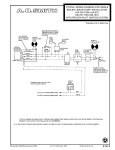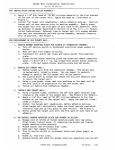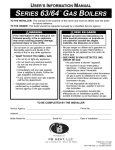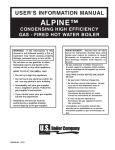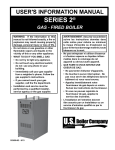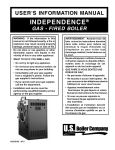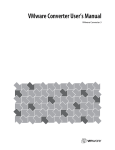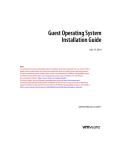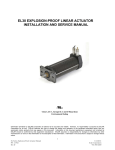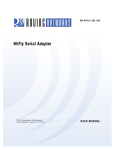Download S-GSXUM-3
Transcript
S-GSXUM-3 00-GSXUM GSX GAS BOILERS USER’S INFORMATION MANUAL WARNING: If the information in this manual is not followed exactly, a fire or explosion may result causing property damage, personal injury or loss of life. Do not store or use gasoline or other flammable vapors and liquids in the vicinity of this or any other appliance. WHAT TO DO IF YOU SMELL GAS: • Do not try to light any appliance. • Do not touch any electrical switch. Do not use any phone in your building. • Immediately call your gas supplier from a phone outside of the building. Follow the gas supplier’s instructions. • If you cannot reach your gas supplier, call the fire department. Installation and service must be performed by a qualified installer, service agency or the gas supplier. TO THE INSTALLER: THIS MANUAL IS THE PROPERTY OF THE OWNER AND MUST BE AFFIXED NEAR THE BOILER FOR FUTURE REFERENCE. TO THE OWNER: THIS BOILER SHOULD BE INSPECTED ANNUALLY BY A QUALIFIED SERVICE AGENCY. PAGE 2 USER’S INFORMATION MANUAL BASIC OPERATION WARNING Service on this boiler should be undertaken only by trained and skilled personnel from a qualified service agency. CAUTION Should overheating occur or the gas supply fail to shut off, turn off the gas supply at a location external to the appliance. Do not use this boiler if any part has been under water. Immediately call a qualified service agency to inspect the boiler and to replace any part of the control system and any gas control which has been under water. A. General. This water boiler is a natural draft appliance and is equipped with controls for proper operation. All controls must be in proper working order. Contact a qualified service agency to provide annual maintenance as specified in the Installation, Operation and Maintenance Manual. B. Control Locations. See Figure 1 for Control and Safety Device Locations. 1a. Limit (Steam Boiler). An electrical device that automatically interrupts the boiler operation when the steam pressure exceeds the “CUT IN” pressure plus the differential (1 to 5 psi). Maximum Pressure setting is 14 psig. The set point is usually less than 5 psig. Original equipment with this boiler is a Honeywell PA404A1009. Boiler operation is interrupted when the steam pressure exceeds the the “CUT IN” pressure plus the differential. Boiler opera-tion resumes automatically when the system pres-sure falls below the “CUT IN” pressure. 1b. Limit Control may incorporate a low water cutoff feature that will interrupt boiler operation upon loss of water in the boiler. If the low water cut-off function is activated to interrupt boiler operation, follow the instructions TO TURN OFF GAS TO THE APPLIANCE (see Figures 3-5) and contact a qualified service agency. 2. Flame Rollout Switch (FRS). An electrical device that automatically interrupts the boiler operation when excessive heat is present in the combustion area. The control is a thermal fuse device that will require replacement if it is activated. If the control has been activated to interrupt the boiler operation, do not attempt to restart the boiler. Contact a qualified service agency. 3. Blocked Vent Switch (BVS) An electrical device that automatically interrupts the boiler operation when there is a blockage in the vent pipe or chimney. The control is located on the side of the draft hood and is a manual reset device. If the control is activated to interrupt operation of the boiler, do not attempt to restart the boiler. Contact a qualified service agency. 4. Pilot. The pilot provides an ignition source for the main burners. Your boiler has an intermittent (spark ignited) pilot. The intermittent pilot ignites only when there is a call for heat and extinguishes when the call for heat ends. See Figure 6. 5. Gas Valve. The gas valve monitors pilot flame and regulates gas flow to the burners and pilot. Figure 1: Control Location USER’S INFORMATION MANUAL 6. Safety Relief Valve. A mechanical device that protects the boiler against excessive pressure. The safety relief valve can discharge a large amount of steam or hot water – the installer should provide piping to discharge water near the floor close to a floor drain. If the safety relief valve discharges water, follow the instructions TO TURN OFF GAS TO APPLIANCE on the Lighting Instructions affixed to the inside of the removable front jacket panel (see Figures 3 through 5 for typical lighting instructions), and contact a qualified service agency. PAGE 3 C. Lighting Instructions. Instructions to place the boiler in operation and to turn off the boiler are shown on the Lighting Instructions Label posted on the inside of the front jacket panel of the boiler. Typical lighting instructions are shown in Figures 3 through 5. Figure 2: Sequence of Operation Intermittent Pilot PAGE 4 USER’S INFORMATION MANUAL Figure 3: Operating Instructions, Spark Ignition Natural Gas & LP Gas USER’S INFORMATION MANUAL Figure 4: Operating Instructions, Spark Ignition Natural Gas & LP Gas PAGE 5 PAGE 6 USER’S INFORMATION MANUAL USER MAINTENANCE WARNING Product Safety Information Refractory Ceramic Fiber Product This appliance contains materials made from refractory ceramic fibers (RCF). Airborne RCF fibers, when inhaled, have been classified by the International Agency for Research on Cancer (IARC), as a possible carcinogen to humans. After the RCF materials have been exposed to temperatures above 1800°F, they can change into crystalline silica, which has been classified by the IARC as carcinogenic to humans. If particles become airborne during service or repair, inhalation of these particles may be hazardous to your health. WARNING Service on this boiler should be undertaken only by trained and skilled personnel from a qualified service agency. Inspections should be performed at intervals specified in the Installation, Operation and Maintenance Manual and this User’s Infor-mation Manual. Maintain manuals in a legible condition. Keep boiler area clear and free of combustible materials, gasoline and other flammable vapors and liquids. Do not place any obstructions in boiler room that will hinder flow of combustion and ventilation air. Avoid Breathing Fiber Particulates and Dust Suppliers of RCF recommend the following precautions be taken when handling these materials: Precautionary Measures: Provide adequate ventilation. Wear a NIOSH/MSHA approved respirator. Wear long sleeved, loose fitting clothing and gloves to prevent skin contact. Wear eye goggles. Minimize airborne dust prior to handling and removal by water misting the material and avoiding unnecessary disturbance of materials. Wash work clothes separately from others. Rinse washer thoroughly after use. Discard RCF materials by sealing in an airtight plastic bag. First Aid Procedures: Inhalation: If breathing difficulty or irritation occurs, move to a location with fresh clean air. Seek immediate medical attention if symptoms persist. Skin Contact: Wash affected area gently with a mild soap and warm water. Seek immediate medical attention if irritation persists. Eye Contact: Flush eyes with water for 15 minutes while holding eyelids apart. Do not rub eyes. Seek immediate medical attention if irritation persists. Ingestion: Drink 1 to 2 glasses of water. Do not induce vomiting. Seek immediate medical attention. A. General Housekeeping (Continuous). 1. Keep boiler area clear and free of combustible materials and obstructions to the free flow of combustion and ventilation air to the boiler. 2. Do not store or use gasoline or other flammable vapors or liquids in the vicinity of the boiler or any other appliance. 3. Do not store or use sources of hydrocarbons in the vicinity of the boiler. Sources of hydrocarbons include bleaches, cleaners, chemicals, sprays, paint removers, fabric softeners and refrigerants. 4. Check safety relief valve for water leakage. If leakage exists, contact a qualified service agency. B. Inspect Vent System (Monthly). 1. The vent pipe must be continuous to chimney with no separations, obstructions, or sags. Vent pipe must be supported at minimum 4 foot intervals and secured with sheet metal screws. 2. The vent system must not have signs of continuous wetness. If signs of continuous wetness are observed, contact a qualified service agency. 3. The vent system must not have signs of deterioration from corrosion or other sources. If there is evidence of deterioration contact a qualified service agency. USER’S INFORMATION MANUAL C. Inspect Pilot and Main Burner Flames (Monthly). 1. Remove front jacket panel by lifting and pulling out. 2. Adjust thermostat to highest setting. Verify operation follows Sequence of Operation (see page 3). 3. View flames through observation port. See Figure 1. 4. Check pilot flame. See Figure 6. The pilot flame should be medium blue covering approximately 3/8" to 1/2" of the thermocouple. If the flame is yellow and lazy, follow instructions TO TURN OFF GAS TO APPLIANCE (see Figures 3-5), and contact a qualified service agency. 5. Check main burner flames. See Figure 6. The flames should have clearly defined inner cones approximately 1-1/2" high and should have a very sharp blue color characteristic. If the flame is yellow and lazy, follow instructions TO TURN OFF GAS TO APPLIANCE (see Figures 3-5), and contact a qualified service agency. PAGE 7 6. Adjust thermostats to normal setting. 7. Install front jacket panel. D. Controls (as required by control manufacturer)¹. 1. Safety Relief Valve. Conduct try lever test as outlined in manufacturer’s instruction tag on the safety relief valve. 2. Low Water Cut-off (if used). Follow instructions provided by control manufacturer. E. General Inspection and Maintenance (Annual). For continued safe operation a qualified service agency must provide a more detailed inspection of burners, heat exchanger and vent system, and provide maintenance as specified in the Installation, Operation and Maintenance Manual. Figure 6: Intermittent Ignition Pilot Configuration and Flames Controls maintenance may be part of annual inspection and maintenance by a qualified service agency if annual frequency is specified by controls manufacturer. 1 TEL. (413) 562-9631 FAX (413) 562-3799








